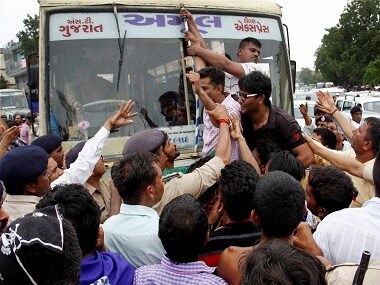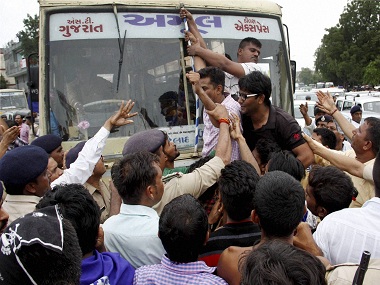The widespread protests in Gujarat against the brutal assault and public shaming of four young Dalit men, following allegations of cow killing, signals ominous developments in the state – that caste wars are back to haunt Gujarat and its political establishment. The state government had barely managed to control the reservation agitation by the powerful Patidars – headed by community leader and youth icon Hardik Patel – and with the Assembly elections a year-and-a-half away, it is now faced with the challenge of keeping the Dalits pacified. Following the brutal assault on the Dalit youngsters – for skinning a cow in Una in the Gir-Somnath district of Gujarat – members of the community staged protests in the state, even as it snowballed across Saurashtra on Tuesday. [caption id=“attachment_2904268” align=“alignleft” width=“380”]  Police detain members of Dalit community who were staging a protest in Ahmedabad. PTI.[/caption] While some call it a rebellion against the conservative federal Hinduism that is prevalent in the state, others point out that it is the lack of caste-wise social empowerment among the youth, which is leading to such incidents. Violence sparked off in various parts of the state following the protests from youths in the community over the delayed action by the state government. The situation in the state worsened when five Dalit youths in Gondal and two in Jamkandorna in Rajkot district attempted suicide in protest of the assault on their fellow community members. On Monday, some 300 Dalits from the adjoining district of Surendranagar, dumped five vehicles filled with cattle carcasses outside the district collector’s office, to protest the treatment meted out to the Dalits in Una – when they were tied to an SUV and beaten up by members of the ‘cow protection committee’. The members supposedly wanted to teach a lesson to the 'culprits' , who were tanners by profession and pleaded that they were transporting the skin of an already dead cow. “Caste politics is not new to Gujarat. Elections have been fought on the basis of caste and tickets have also been distributed to candidates on the basis of caste down to the local levels. So, I am not surprised that such issues are not dealt with an iron hand,” said Hemant Shah, political analyst and renowned economist. “The Congress did it a bit more blatantly in the name of KHAM (Kshatriya, Harijan, Adivasi and Muslim), the BJP has been more clandestine about it,” Shah said. Though appeasement of the Dalits in Gujarat might not reap any local benefits – as a meagre seven percent of the state’s population comprises SC tribes, according to Navsarjan, a grassroots Dalit organisation – but atrocities on a community like the Dalits has a national impact, something that Prime Minister Narendra Modi would not like to hear now, especially from his home state. Social Scientist Vidyut Joshi, pointed out, “Such agitations come as a reaction of the anti-incumbency of the government and leads to unrest among the youth.” “The Patidar agitation, followed by the rally of the OBCs last year were a result of the unrest in the mind of the youth. Ad hoc appeasement at the time of appeasement only backfires,” Joshi said. Citing the example of the announcement of EBC (Economically Backward Class) quota during the Patidar agitation, he pointed out that it only backfired and the agitation went on to garner even more support from the youth. “All this is a result of the bursting of the bubble created called, the ‘Gujarat Model’,” pointed out Shah. He said that statistics have revealed that industrialisation has been on a rise for the last one decade. “But where are the jobs?” he questioned. He pointed out that such agitations were being given a caste colour, but in reality it just reflected the unrest among the dissatisfied youth in Gujarat, with the present political system. Analysts point out that the entire issue might have taken a political turn with the opposition, Congress party, having jumped on the fray and demanding an inquiry. They also decided to take out a rally in Ahmedabad, protesting against the attacks on the Dalit men and the non-action against people who claim affiliation to the Vishva Hindu Parishad and the cow protection committee. “Giving it a political colour is the easiest thing to do. With elections a year-and-a-half away, sustaining without such issues is a difficult thing, especially for the Congress, which lacks in its organisational skill specifically in Gujarat,” Joshi added. Gaurang Jani, who is advisor to the state’s OBC commission, said, “Such incidents are a reflection of the conservative federal Hinduism.” Jani said that the caste system in Gujarat was prevalent and the lack of social engineering and empowerment was leading to such incidents. “On one hand, you have initiatives like the Swachh Bharat Abhiyan, but then the sections doing its tasks are neglected,” pointed out Jani. Caste clashes of Patidars against Chaudhary, Thakor, Rabari or Koli communities are often seen at the village or micro level, and sometimes in cities, like the serious clashes between the Patels and Rabaris . Jani pointed out that the pertinent question was why such clashes were becoming more rampant. He pointed out that the social engineering in government programmes have been missing, especially for the Dalits, Chamars and Valmikis. He also warned that such clashes would be on a rise in the coming few months, and political ambitions would only stoke the emotions further, meaning that it would not just be restricted to the grassroots but could also spread to urban areas, as was seen during the Patidar agitation. Gujarat government’s figures reveal that at least 1,000 Dalits become victims of serious offences like murder, rape, mob lynching and boycott each year. Though the Anandiben Patel led government has handed over the inquiry to the CID, such steps are not enough to pacify the agitators; the protests won’t settle down until the state government comes out with a concrete plan, temporary solutions and announcements won’t do.
The widespread protests in Gujarat against the brutal assault and public shaming of four young Dalit men signals the return of caste wars in the state.
Advertisement
End of Article


)

)
)
)
)
)
)
)
)



